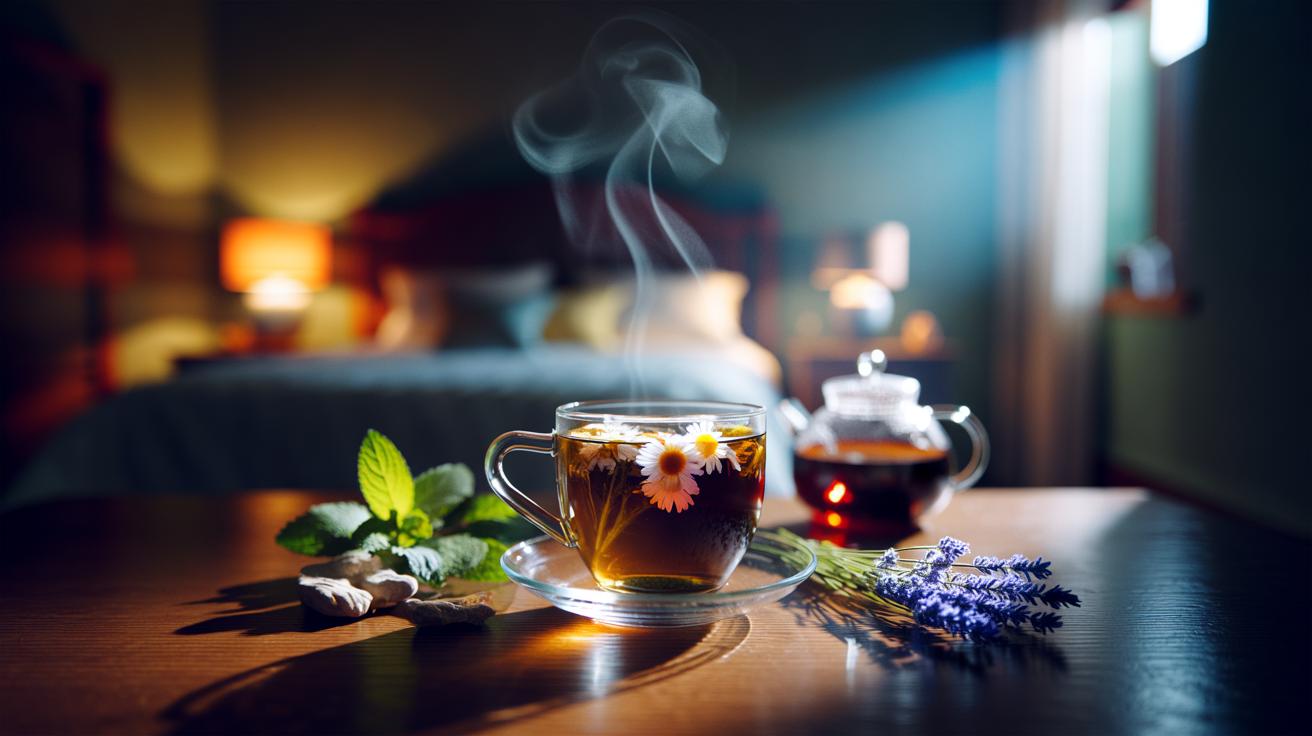In a nutshell
- 🌙 Herbal sleep support: Warm, caffeine-free teas gently reduce alertness by modulating GABA, supporting adenosine, and activating the parasympathetic response, aided by heat and aroma.
- 🌿 Evidence-led herbs: Chamomile (apigenin), lemon balm (rosmarinic acid), valerian (valerenic acids), passionflower (flavonoids), and lavender (linalool) are caffeine-free options with calming mechanisms.
- ☕ Brewing that works: Use proper water temperatures, cover the cup to trap terpenes, and drink 45–60 minutes before bed; adjust dose and steep time for taste and effect.
- 🧪 Smart pairing: Choose single herbs to gauge response, then blend (e.g., lemon balm + passionflower for worry, a touch of valerian for sleep onset), avoiding alcohol and late caffeine.
- 📝 Safety and expectations: Check interactions (sedatives, antidepressants, liver issues), trial cautiously if pollen-sensitive, and emphasise consistency and sleep hygiene—this is a gentle aid, not a cure-all.
Warm, caffeine-free herbal tea has become the quiet ally of restless nights, offering a gentle, evidence-informed way to ease the mind. A well-brewed cup does more than soothe: plant compounds interact with receptors tied to arousal, stress, and sleep pressure, steering the nervous system toward calm. Heat and hydration support that shift, while fragrance and ritual signal the brain to wind down. The combination of warm liquid, botanical chemistry, and a consistent evening habit can lower alertness without the blunt force of pharmaceuticals. Here is how specific molecules work, which herbs to choose, and the simple preparation tweaks that make the biggest difference.
How Plant Molecules Nudge the Brain Toward Sleep
Several herbs used in bedtime blends influence the brain’s calming circuitry. Chamomile delivers apigenin, a flavone that binds to GABA-A receptors, encouraging neuronal inhibition associated with drowsiness. Lemon balm contains rosmarinic acid, which appears to boost GABA by inhibiting its breakdown, easing mental chatter. In lavender, aromatic terpenes like linalool modulate glutamate signalling and promote relaxation through olfactory pathways. Valerian root contributes valerenic acids, also acting on GABA receptors, with some evidence for reduced sleep latency. Together these mechanisms dampen cortical overdrive and ease the “tired but wired” state that sabotages bedtimes.
These compounds also interface with adenosine, the body’s sleep-pressure messenger. While not sedatives in the pharmaceutical sense, they slightly tilt the balance toward restfulness, complementing natural circadian cues. Heat matters: the warmth of an infusion stimulates peripheral vasodilation, which can assist the body’s pre-sleep temperature drop. A quiet, aromatic cup about an hour before bed acts as a low-risk, multi-sensory nudge to the parasympathetic system. The result is a modest, cumulative reduction in alertness that pairs well with sound sleep hygiene.
Herbs to Brew and the Science Behind Them
Five stalwarts anchor many bedtime blends, each with a signature profile. Chamomile is the classic choice for its apigenin content and gentle taste. Lemon balm helps smooth restlessness, especially when worry delays sleep. Valerian root is stronger and earthier, useful when sleep onset is the issue. Passionflower (Passiflora incarnata) contains flavonoids that seem to support GABAergic tone, easing pre-sleep rumination. Lavender adds fragrant terpenes that cue relaxation even before the first sip. Choose single-herb infusions to gauge your response, then blend thoughtfully.
| Herb | Key Compounds | Primary Mechanism | Caffeine-Free | Typical Steep Time |
|---|---|---|---|---|
| Chamomile | Apigenin | GABA-A modulation | Yes | 5–7 minutes |
| Lemon balm | Rosmarinic acid | GABA reuptake inhibition | Yes | 5–8 minutes |
| Valerian root | Valerenic acids | GABAergic support | Yes | 8–12 minutes |
| Passionflower | Flavonoids | Anxiolytic, GABA support | Yes | 6–10 minutes |
| Lavender | Linalool, linalyl acetate | Terpene-mediated calming | Yes | 4–6 minutes |
Quality and freshness count: seek whole blossoms or well-cut leaves with a vivid aroma, stored away from light. Start with a teaspoon per cup, adjust by taste and effect, and avoid sweeteners that spike alertness. If you take sedatives, antidepressants, or have liver concerns, consult a clinician before using valerian. Pregnant or breastfeeding readers should prioritise chamomile and lemon balm only after medical advice. The aim is gentle synergy, not sedation: a steady cup each evening often works better than sporadic, strong brews.
Timing, Temperature, and Ritual: Practical Steps for Results
Brewing technique shapes chemistry. Use water just off the boil for roots like valerian; keep to 85–90°C for delicate flowers such as chamomile to preserve volatile oils. Cover the cup while steeping to trap aromatic terpenes. Aim to drink 45–60 minutes before lights out, allowing time for absorption and for the warmth to encourage that subtle drop in core temperature. Switch to caffeine-free infusions from midday to prevent residual stimulation. If you wake to urinate, complete your cup earlier in the evening and sip slowly. Consistency wins: a nightly routine compounds small, calming effects.
Anchor the ritual with sleep-friendly cues. Dim lights, swap scrolling for a paperback, and keep room temperature cool. Gentle breathing while the tea steeps (four-second inhale, six-second exhale) reinforces parasympathetic tone. If stress is the villain, try a blend of lemon balm and passionflower; for difficulty nodding off, add a little valerian. Avoid alcohol as a “nightcap”; it fragments sleep architecture. Those with pollen allergies should test chamomile cautiously. Keep notes for a week: assess taste, relaxation, and sleep efficiency, then adjust herb, dose, or timing based on your observations.
Herbal tea cannot fix a misaligned body clock, but it can reduce the mental and physiological sparks that keep you alert when you crave rest. The real power lies in repetition and context: safe phytochemicals, heat, aroma, and a quiet environment working together. A measured cup each evening is a calm decision, not a cure-all. If you try this tonight, which herb will you begin with, how will you shape your ritual around it, and what small change could you keep for a fortnight to test whether your nights become easier?
Did you like it?4.5/5 (24)
